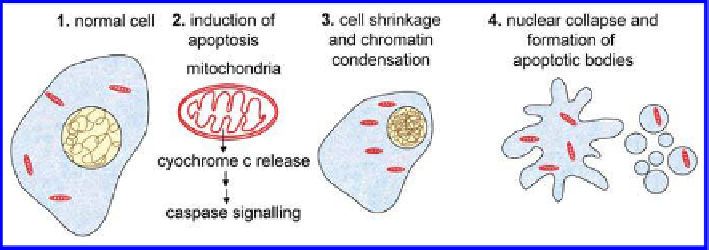Biology Reference
In-Depth Information
In the adult organism, the number of cells is kept relatively constant
through cell death and division. Cells must be replaced when they malfunction
or become diseased, but proliferation must be offset by cell death.
35
This
control mechanism is part of the homeostasis required by living organisms
to maintain their internal states within certain limits. Loss of cells by injury,
for instance trauma, is undesired. By contrast, apoptosis generally confers
key advantages during the life cycle of a multicellular organism. Apoptosis
occurs during the development of multicellular organisms and goes on
throughout the adult life. For example, the differentiation of ingers and toes
in developing human embryo occurs because cells between ingers commit
suicide and the consequence is that the digits are separate. A severely
damaged cell commits suicide to prevent damage from being spread on to
surrounding cells. Apoptosis is thus involved in fundamental processes of life,
like embryonic development, tissue homeostasis or immune defence. Defects
in apoptosis cause or contribute to developmental malformation, cancer and
degenerative disorders.
6.3.2
The Process of Apoptosis
In contrast to the diversity of stimuli generating apoptosis, signalling and
execution of apoptosis is mainly driven by caspases, a family of cysteine
proteases. Activation of caspases, in turn, occurs as a consequence of
cytochrome c release from mitochondria.
The apoptotic program can also
be initiated artiicially by delivering a load of exogenous cytochrome c into
the cytosol.
37
Hallmarks of apoptosis are numerous. They comprise cell
shrinkage, plasma membrane blebbing, nuclear and DNA fragmentation and
the formation of apoptotic bodies.
38
39
Figure 6.14.
Schematic of cell destruction during apoptosis.

















Search WWH ::

Custom Search